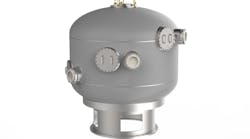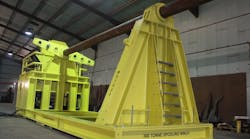Editor's note: This article first appeared in the May-June issue of Offshore magazine. Click here to view the full issue.
By Jeremy Beckman, Editor-Europe
Testing of the world’s first offshore green hydrogen production pilot plant will shortly transfer from the harbour at Saint Nazaire, western France to an open-sea test site, operated by French engineering school Centrale Nante.
Nantes-based Lhyfe, which produced the first hydrogen using power from onshore wind turbines in 2021, has adapted its technology to operate on a floating platform, named “Sealhyfe.” The production module, secured to a Wavegem wave energy structure, began operating in the harbour last September and has been producing up to 400 kg/d of hydrogen. On completion of this initial six-month phase, the Sealhyfe platform will be relocated to the SEM-REV test site in the Atlantic, 20 km from Le Croisic. Here it will be powered by the Floatgen floating offshore wind turbine (another demonstrator) that has been operating continuously since installation in 2018.
Lhfye, the project developer, collaborated with US company Plug Power Inc to adapt the latter’s electrolyzer to operate on a floating platform. Other French offshore/marine renewable energy specialists contributing to the program are local shipyard/engineering group Chantiers de L’Atlantique, responsible for structural strengthening to withstand environmental stress, the ventilation systems and the electrical architecture; GEPS Techno, which developed the Wavegem platform, also working with Eiffage Energies Systèmes on integration of the production equipment with the platform; Port of Saint-Nazaire, which facilitated assembly and testing; and Kraken Subsea Solutions, which assisted the design of the underwater connection to the Floatgen wind turbine developed by a consortium led by BW Ideol. This recently exceeded 22 GW of electricity production since commissioning in late 2019, and has operated at maximum capacity for more than 80% of the subsequent period.
According to Lyhfe’s Technical Director Thomas Créach, who has a background in offshore oil and gas and renewable energy (as do other members of the management team), power used during the initial trial period in the harbour is supplied locally via the French marine renewable energy hub: the electrolyser has a 1-MW requirement and the system auxiliaries 0.3 MW. The platform, with an overall weight of 330 metric tons, measures 21 m long and 14 m wide, with an above-water height of 6 m.
“All the tests that are meant to be performed offshore (for a longer period of time) have been done during the harbour tests phase,” Créach said. “The remaining part is the impact of the waves and exposure to weather conditions, which will be tested at SEM-REV. The system has been custom- designed for offshore applications, so it is already compliant and planned for this deployment, by design. However, some of the equipment could be modified following the port tests in order to increase its reliability and particularly its mechanical resistance in offshore conditions. The strategy of 100% autonomous control on a system powered by intermittent energy will also be the second offshore challenge.”
“Through this pilot site, Lhyfe will produce the first kilograms of renewable green hydrogen at quay and then at sea, operating automatically, in the most extreme conditions. The company has voluntarily set the bar high by installing its production unit on a floating platform, connected to a floating wind turbine. The Sealhyfe platform must therefore meet several major and unprecedented challenges associated with hydrogen production at sea, including converting the electrical voltage from the floating turbine; pumping, de-salinating and purifying seawater; and deploying electrolysis to break down water molecules in order to produce green hydrogen. Other goals of the sea trial are managing the system’s impact on the platform’s motions – listing, swinging movements, accelerations – demonstrating that the system can withstanding premature ageing of components caused by corrosion, impacts, and temperature variations. And being able to operate fully automatically without interventions, except during scheduled maintenance periods.
“Since the company’s early days, Lhyfe has been convinced of the central role offshore has to play in large-scale renewable green hydrogen production. In 2021, the company built its Lhyfe Pays de la Loire plant in Bouin, western France Vendée to prove the feasibility of producing renewable green hydrogen from a wind farm (and managing its intermittency, and doing so at a good price). For more than a year now, that plant has been delivering its hydrogen to the multi-energy filling station in La Roche-sur-Yon, and to the Lidl logistics center where there are 98 hydrogen-powered forklifts. With Sealhyfe, Lhyfe wants to demonstrate that producing renewable green hydrogen at sea is possible and define the optimizations required for future, larger-scale systems. That’s why the company chose the most extreme conditions for its pilot (floating platform plus floating wind turbine). This has never been done and it includes a series of major and unprecedented challenges – but as a world premiere, that helps the market to take a step forward.”
The program has the support of the Pays de la Loire region, the Pôle Mer Bretagne Atlantique cluster, and France’s strategic committee (CSF) for marine industry operators. Other aims are to identify port areas and facilities that could accommodate different prototypes, and the industrial requirements and port infrastructure needed for assembling and integrating the equipment that would produce offshore hydrogen on a mass scale.
As for Lyhfe’s own green hydrogen ambitions, by 2030-2035 offshore could represent an additional installed capacity of around 3 GW for the company, Créach said. “Our next offshore project will be to develop, build and operate a larger production unit to demonstrate the technical and financial viability of producing renewable hydrogen offshore and transporting it by pipeline to serve customers.” Various offshore deployment solutions are under consideration, he added, including renewable hydrogen production platforms either on existing fixed structures or on fixed or floating foundations, “For each one, specific partners will be involved, some of them already contributors to the Sealhyfe development. However, Lhyfe remains the architect of the global solution and the operator of these systems in order to offer hydrogen to offtakers.”










